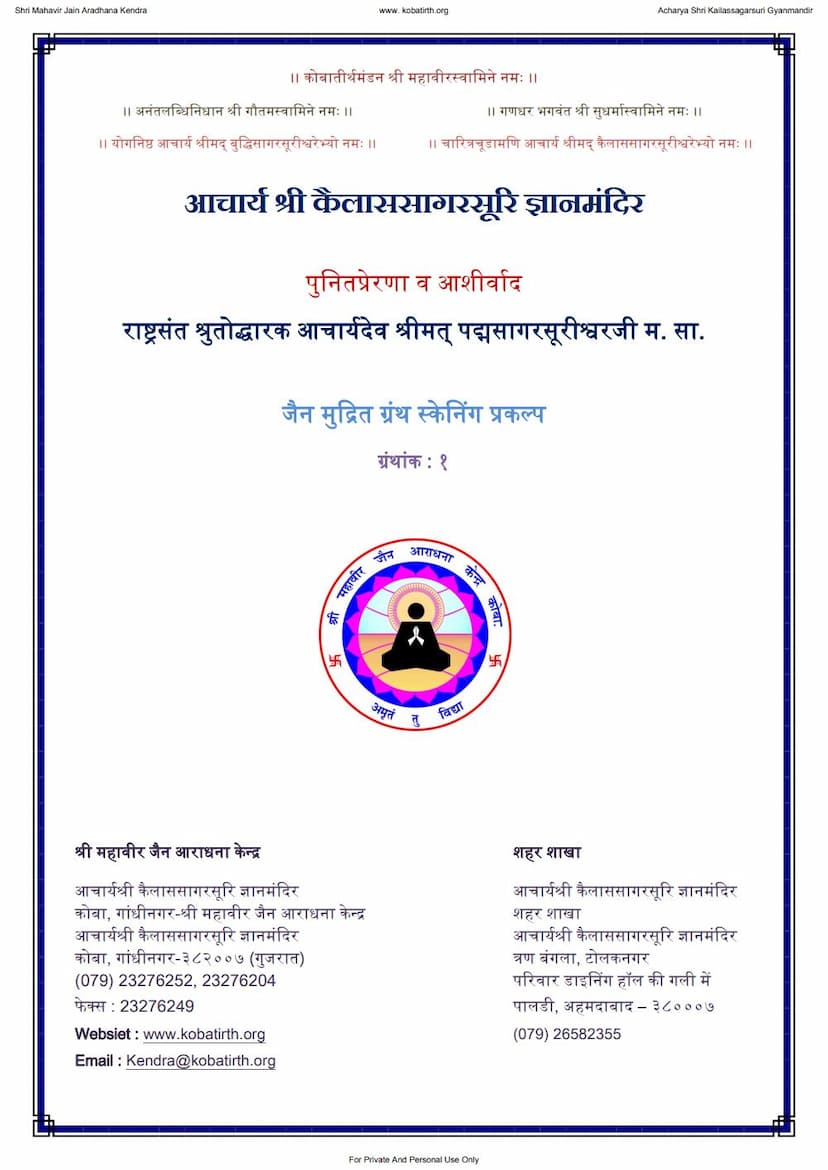Agam 39 Chhed 06 Mahanishith Sutra Shwetambar
Added to library: September 1, 2025

Summary
Based on the provided text, here's a comprehensive summary of the Jain text, Agam 39 Chhed 06 Mahanishith Sutra Shwetambar, as edited by Purnachandrasagar and published by Jainanand Pustakalay:
Overall Focus:
The text, "Mahanishith Sutra," is a significant Jain scripture, primarily focusing on the stringent rules and practices for ascetics (monks and nuns) within the Shwetambar tradition of Jainism. It elaborates on various aspects of ascetic conduct, penance, purification, and the consequences of transgressions. The text emphasizes the importance of meticulous adherence to Jain principles and the severe repercussions of deviating from them, illustrating these through detailed discussions and narratives.
Key Themes and Contents:
The provided pages primarily delve into the following:
-
The Nature and Importance of Agamas (Sacred Texts):
- Pages 6-11 provide a historical overview of the compilation and preservation of Jain Agamas.
- It outlines the six historical "Vachanas" (recitations or councils) held over centuries to consolidate and protect the Jain scriptures from damage caused by challenging times, famines, and societal upheavals.
- These Vachanas aimed to ensure the accuracy and continuity of the sacred teachings, highlighting the immense effort involved in preserving this knowledge.
- The text acknowledges the profound importance of Shruta Jnana (scriptural knowledge) as a guiding light in the spiritual journey.
-
The Mahanishith Sutra:
- The core of the text is the "Mahanishith Sutra" itself, which is presented in its original Prakrit language (pages 12-97). The scriptural text, transliterated from Prakrit to Devanagari and then possibly translated or expounded upon in Gujarati and Sanskrit, details profound ethical and disciplinary principles.
- The Central Concept of "Salla" (Thorn/Obstacle) and its Removal ("Salluharana"): A significant portion of the sutra (pages 12-28 and onwards) focuses on the concept of "salla" (thorn or obstacle) that impedes spiritual progress. The text elaborates on the nature of these thorns, which are primarily internal – rooted in passions like attachment (raga), aversion (dvesha), ignorance (moha), and the resulting negative actions and karmic consequences.
- The Process of Purification ("Salluharana"): The sutra details the process of removing these thorns, which involves self-reflection, confession ("pratikraman"), penance, austerity, and strict adherence to vows and ethical conduct. It stresses that true purification comes from internal transformation and sincere remorse, not just outward actions.
- Detailed Rules of Conduct for Ascetics: The text outlines numerous specific rules and guidelines for monks and nuns, covering aspects like:
- Speech and Action: The need for right speech and action, avoiding harmful or untruthful talk.
- Conduct Towards Others: Emphasizing compassion, forgiveness, and proper interaction with all living beings.
- Self-Discipline: Strict control over the senses, mind, and body.
- Penance and Austerity: The importance of various forms of penance ("tapa") for purifying the soul and shedding karmas.
- Purity of Intent: The critical role of pure intentions behind actions.
- Consequences of Transgressions: The text vividly describes the severe karmic consequences of violating ascetic rules, often using vivid imagery to illustrate the suffering in lower realms of existence and the long cycle of rebirth.
- The Role of Repentance and Penance: The Mahanishith Sutra highlights that sincere repentance and appropriate penance are crucial for overcoming transgressions and purifying oneself. It differentiates between types of penance and their efficacy.
- Examples and Narratives: The text likely contains stories or examples (though not fully detailed in the provided pages) of ascetics who either succeeded through strict adherence or faced severe consequences due to laxity, serving as cautionary tales and inspirations.
- The "Pancha Mangala" (Five Auspicious Ones): The latter part of the text (pages 56 onwards) discusses the significance and practice of reciting the "Pancha Namaskara Mantra" (Namo Arihantanam, Namo Siddhanam, Namo Aiyariyanam, Namo Uvajjhayanam, Namo Loye Savvasahunam) as a fundamental practice for purification and spiritual advancement. It details the proper method of venerating these five auspicious entities.
- Discussions on "Kusila" (Improper Conduct): A significant portion is dedicated to defining and detailing various forms of "kusila" or improper conduct among ascetics. This includes offenses related to knowledge, conduct, penance, and other areas, emphasizing the need for constant vigilance and self-examination.
- The Importance of Guru's Guidance: The text implicitly and explicitly highlights the indispensable role of a qualified Guru in guiding disciples through the complex path of asceticism and purification.
Publisher and Editorial Information:
- The text is published by Jainanand Pustakalay and is associated with Shri Mahavir Jain Aradhana Kendra and Acharya Shri Kailassagarsuri Gyanmandir.
- The editing and revision process involved the guidance and inspiration of several respected monks and scholars (mentioned on pages 5-6), with Purnachandrasagarji M.S. playing a key role as the writer and presenter.
- The publication date is mentioned as Samvat 2061 (approximately 2004 CE).
In essence, the Mahanishith Sutra, as presented in this excerpt, is a profound and detailed guide for Jain ascetics, emphasizing rigorous self-discipline, purification through penance, and the critical importance of ethical conduct and adherence to the teachings of the Tirthankaras to achieve liberation.